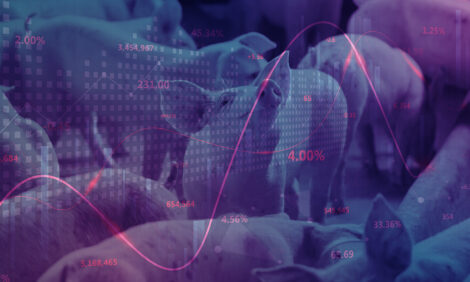



Pork Outlook Report - January 2003
By U.S.D.A., Economic Research Service - This article is an extract from the January 2003: Livestock, Dairy and Poultry Outlook Report, highlighting Global Pork Industry data. The report indicates that pork production is expected to reduce leading to higher hog prices in 2003.| Overview |

|
Inventories of hogs and pigs, together with producer breeding intentions reported in the Quarterly Hogs and Pigs report released on December 30, suggest lower pork production and higher hog prices in 2003.
Pork production in 2003 is expected to decline by less than 2 percent. Hog prices are expected to average in the high $30s, compared with the mid $30s in 2002.
| Quarter by Hogs and Pigs Report in Line With Expectations |

Inventories of hogs and pigs, together with
producer breeding intentions reported in the
Quarterly Hogs and Pigs report released on
December 30, suggest lower pork production and
higher hog prices in 2003.
Retail pork prices should increase as well, particularly if current
expectations for lower per capita supplies of beef
and poultry are realized.
Pork production in 2003
is expected to decline by less than 2 percent, to
about 19.4 billion pounds. The 51-52 percent lean
live equivalent hog price is expected to average
around $38 per hundredweight in 2003, an increase
of more than 8 percent over the 2002 average.
Retail pork prices are expected to increase about 1
percent in 2003, to an average of about $2.69.
| Lower Pork Production in 2003 |
The Quarterly Hogs and Pigs report indicated that
the June-August 2002 pig crop was about 2 percent
below the summer quarter of 2001. The June
August 2002 pig crop will be slaughtered in the
first quarter of 2003. The lower June-August pig
crop, plus anticipated imports of slaughter hogs and
feeder pigs from Canada should leave the first
quarter 2003 slaughter about unchanged from the
same period a year ago.
The September-November 2002 pig crop came in 2
percent lower than a year ago. The September-November
pig crop is typically slaughtered in the
second calendar quarter of the following year.
Thus, the second quarter 2003 slaughter is expected
to feel the brunt of the lower pig crop. Despite
higher live imports, the second quarter 2003
slaughter is expected to fall by more than 2 percent.

Second farrowing intentions for the December-February quarter of 2003 came in at 1 percent below the same period in 2002, and unchanged from the first intentions reported in the September quarterly report. If producer intentions are realized, slaughter in the third calendar quarter of 2003 should fall more than 2 percent below 2002’s summer slaughter.
Producers indicated intentions to farrow 3 percent fewer sows in the March-May 2003 period. If producer intentions are realized, slaughter in the fourth quarter of 2003 should fall almost 2 percent below the same period last year.
| Producer Returns Are Key to Herd Rebuilding, Timing Uncertain |
Higher hog prices in 2003 could go part of the way
toward creating incentives for producers to retain
gilts for breeding herd rebuilding. While higher
hog prices this year will improve producer returns,
feed costs will be another key to herd rebuilding
decisions. Consequently, the industry will focus on
weather trends in the Corn Belt States. “Normal
weather conditions” could bring about lower feed
costs that would support producer returns.
Historically, producers have increased the number
of sows farrowing after 6 to 9 months of above-breakeven
returns. But the ongoing changes in the
U.S. pork sector structure may also have altered the
timing of producer decisionmaking, adding even
more uncertainty to forecasting turning-points of
hog production cycles.
| Pork Consumption Higher in 2002, but at Lower Prices |
Domestic pork consumption in 2002 was 19.7
billion pounds, which translates into per capita
consumption of 51.3 pounds of retail weight pork.
On a per capita, retail weight basis, Americans
consumed about 1 more pound of pork in 2002
than in 2001.
Increased quantities of pork traded at lower prices
in 2002, however. On average, wholesalers paid
packers lower prices for pork cuts in 2002, and
U.S. consumers paid lower retail prices for the pork
purchased at retail outlets. Wholesale pork prices--as
measured by the composite cutout-- were 19
percent lower in 2002 than in 2001. Retail prices
were about 1 percent lower in 2002 than in 2001.
| October Dock Strike Likely Culprit of Slow October Exports |
U.S. pork exports in October were lower than
anticipated at 121 million pounds, down more than
2 percent from September, and almost 4 percent
from October 2001.
It is likely that some Asia-bound
exports were slowed by the West Coast dock
strike. Japan’s cumulative share of U.S. exports
fell below 50 percent for the first time in 2002,
suggesting that the strike might have hindered
shipments into Japan’s traditionally active holiday
pork market. At least part of the seasonal increase
in fourth-quarter U.S. pork exports is likely to be
made up in the November-December period.
In total, through October the United States exported
1.32 billion pounds (in carcass weight equivalents),
an increase of almost 3 percent over the same
period in 2001.
Under the terms of the free-trade agreement
between the United States, Mexico, and Canada
(NAFTA), Mexican barriers to pork imports were
rescinded on January 1, 2003. However, on
January 7, the Mexican Pork Council petitioned its
Secretariat of Economy, charging that “Imports of
pork meat from the United States of America have
allegedly come into the Mexican market at prices
significantly below the cost of prooduction…
exporters and importers of selected U.S. pork meat,
particularly hams and shoulders, practiced price
discrimination from April 1 to September 2002.”
The Mexican Pork Council seeks relief in the form
of countervailing duties and/or compensatory
duties on selected cuts of imported U.S. pork.
Respondents to the petition
have 30 working days to respond to questionnaires
required from the Secretariat. Preliminary findings
of the Mexican Government’s investigation will be
reported in about 4 months.
Mexico is the second largest export market for U.S.
pork, after Japan. In October, Mexico accounted
for about 20 percent of total U.S. pork exports.
Since October 1998, Mexico has restricted imports
of U.S. live hogs with countervailing duties to
compensate producers there for what the Mexican
Government maintains is underpricing of U.S. hogs
imported into Mexico.
| Imports of Feeder Pigs from Canada Achieve Record Level in October |
The U.S. Census reported that the United States
imported 393,000 feeder pigs from Canada in
October, the highest number ever. Moreover,
feeder pigs accounted for 71 percent of imports,
also a record.
Through October, the number of feeder pigs
imported from Canada increased by more than 20
percent, while the number of slaughter hogs
decreased by more than 7 percent. The slowdown
in U.S. slaughter hog imports is likely related to
both an increase in slaughter capacity in Canada,
and more intensive use of existing Canadian
capacity. In Ontario, a new plant in Mitchell and
an expansion of an existing plant in Breslau
increased capacity by about 9,000 head per week.
Moreover, increased flexibility of labor rules
allowed two major plants in Ontario to begin
running Saturday shifts during the September-January
period when demand for slaughter space is
highest. In Manitoba, the Maple Leaf plant
achieved its goal of 40,000 head per week in 2002.
In Alberta, the 2002 slaughter increased almost 17
percent over the kill in 2001, suggesting that the
investments made by the new Quebecois owners of
the province’s major slaughter facility have
allowed it to increase production.

| Further information |
Links
For more information view the full Livestock, Dairy and Poultry Outlook - January 2003 (pdf)Source: Livestock, Dairy and Poultry Outlook - U.S. Department of Agriculture, Economic Research Service - January, 2003






